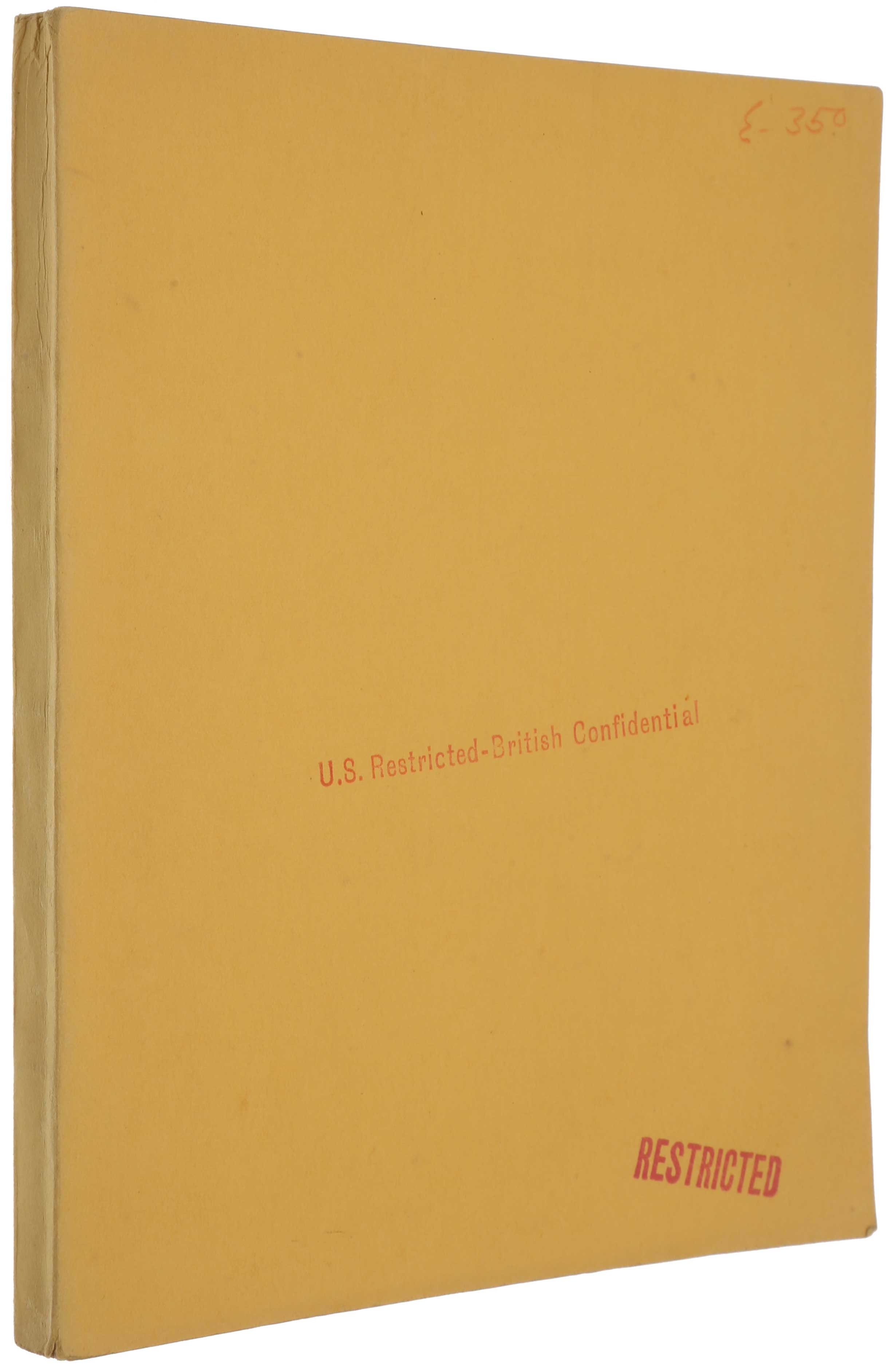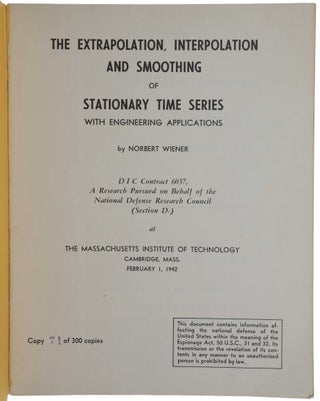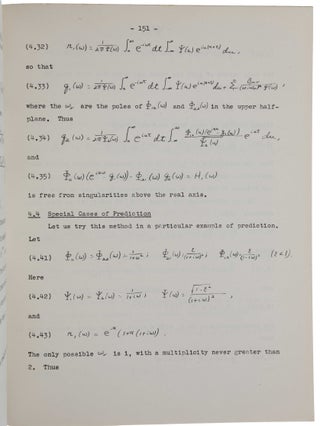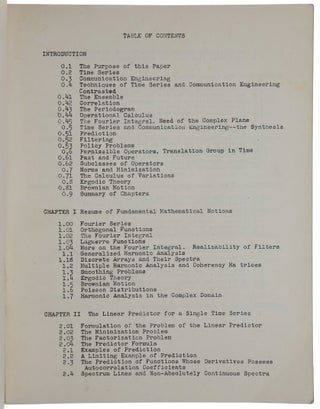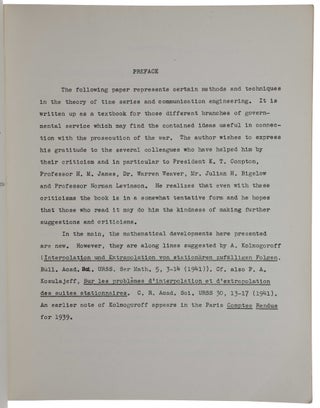The Extrapolation, Interpretation and Smoothing of Stationary Time Series with Engineering Applications. DIC Contract 6037, A Research Pursued on Behalf of the National Defense Research Council.
[Washington, DC: National Defense Research Council], 1942. Extremely rare first edition of this classic work which laid the foundations of modern communication and control theory. “It has been the opinion of many that Wiener will be remembered for his Extrapolation long after Cybernetics is forgotten. Indeed few computer-science students would know today what cybernetics is all about, while every communication student knows what Wiener’s filter is. The work was circulated as a classified memorandum in 1942 [offered here], as it was connected with sensitive war-time efforts to improve radar communication. This book became the basis for modern communication theory, by a scientist considered one of the founders of the field of artificial intelligence. Combining ideas from statistics and time-series analysis, Wiener used Gauss’s method of shaping the characteristic of a detector to allow for the maximal recognition of signals in the presence of noise. This method came to be known as the ‘Wiener filter’” (MIT Press). After the War the report was eventually published as The Extrapolation, Interpretation and Smoothing of Stationary Time Series with Engineering Applications, MIT Press, Cambridge, Mass., 1949. Provenance: This copy was sent to Britain and differs from another copy we have handled. This copy has ‘U.S. Restricted – British Confidential’ and ‘RESTRICTED’ stamped on the front wrapper, the other copy had 'OSRD REPORT' (Office of Scientific Research and Development Report) and ‘DECLASSIFIED’. According to Stuart Bennet (A History of Control Engineering, 1930-1955 (1993), p. 184, n. 49), “Copies were sent to England for R. H. Fowler, G. H. Hardy, [J. E.] Littlewood, A. Milne Thompson, R. V. Southwell, G. I. Taylor and J. McNaughton Whittaker.” Fowler (1889-1944) was an astrophysicist, Hardy (1877-1947) and Littlewood (1885-1977) pure mathematicians, Southwell (1888-1970), Taylor (1886-1975) and Milne Thompson (1891-1974) applied mathematicians. Fowler, Hardy, Littlewood and Taylor were Cambridge men, Milne Thompson was then at the Royal Naval College Greenwich, and Southwell was Rector of Imperial College, London. Fowler might seem to be an unlikely recipient, but during the War he worked for the Ordnance Board as scientific liaison with Canada and the United States, at the same time Wiener was working on the control of anti-aircraft guns (see below). “Working with the Fire Control Division of the National Defense Research Committee during World War II, Wiener was assigned the critical problem of anti-aircraft control, specifically the task of designing a gun that could accurately and automatically aim at a high-speed moving target guided by human intelligence. Wiener and his assistant, Julian Bigelow, developed a system whereby they would treat the airplane’s path as a stationary time series and use probability theory to extrapolate the airplane’s future path from its past actions. The theory Wiener developed and explained in this classified document for internal government use only became a milestone in communication theory. Claude Shannon, in his Mathematical Theory of Communication notes: ‘Communication theory is heavily indebted to Wiener for much of its basic philosophy and theory. His classic NDRC report The Interpolation, Extrapolation, and Smoothing of Stationary Time Series, to appear soon in book form, contains the first clear-cut formulation of communication theory as a statistical problem, the study of operations on time series.’ Wiener’s famous report did indeed appear in book form in 1949, seven years after this classified report. Wiener’s report was extremely difficult to read, and thus was known to generations of students after the war as the ‘yellow peril’ after its plain yellow wrappers” (Origins of Cyberspace). “Wiener had always been inclined toward applications of mathematics in science and engineering, but before World War II his central contributions had been of an essentially general mathematical nature. The war focused his interests into concrete directions, and from that time onward his contributions were primarily in the direction of applications. “The first of these was to prediction theory, which was involved in anti-aircraft fire control. This was a natural and fairly straightforward application of the theory of stochastic processes, which J. L. Doob and others in the United States had developed on a rigorous basis, following Kolmogorov's mathematical formulation of the foundations of probability theory in 1933. Unsurprisingly, in view of the exigencies of the war, Kolmogorov himself had begun to publish on prediction theory, but his work was unknown to Wiener until I chanced to mention it to him at a meeting. However, after incisive early work, Kolmogorov left the subject, while Wiener developed it rather fully, including its engineering aspects, during and after the war. His mathematical theory, which modeled deviations from the signal, or ‘noise,’ as a stationary multivariate Gaussian stochastic process, was developed jointly with the younger mathematicians E. J. Akutowicz and, especially, P. Masani. The engineering implementation was developed in collaboration with Julian Bigelow. The basic theory was given in a report published during the war; this was effectively a draft of his monograph, ‘Extrapolation, Interpolation, and Smoothing on Stationary Time Series,’ published in 1950 [sic]. “This work represents a special case of the study of mechanisms as devices that effect an input-output transfer, with regard to smoothing, feedback, and stability, independently of internal dynamics. In part, cybernetics emerges naturally from this study, for which the prediction theory was Bottom of Forman important prototype. In principle, as Wiener stressed, similar considerations apply to the biological and social sciences as well as to the engineering and physical sciences. However, the former systems are relatively complex and lacking in symmetries, so that a general theory cannot be expected to apply to them with the same specificity as in the case of the temporally or spatially invariant models used in electrical engineering and physics. The latter were the systems to which Wiener’s mathematical investigations before the war related. Correspondingly, it was the breadth and coherence of the cybernetic philosophy, and its usefulness as a guide to innovative development and experiment, that were its main contributions, rather than any difficult or incisive technical accomplishment. However, its permeation of scientific thought has been so extensive that its novel and stimulating character before and during the war cannot now be readily appreciated” (Irving Segal, ‘Norbert Wiener November 26, 1894-March 18, 1964,’ Biographical Memoirs of the National Academy of Sciences 61 (1992), pp. 405-6). “Norbert Wiener was one of the most original mathematicians and influential scientists of the twentieth century. He developed a new, purely mathematical theory, an integral calculus for functions of infinitely many variables known as functional integration. It has been of great importance for probability and theoretical physics. Wiener made huge strides in the harmonic analysis of functions of real and complex variables. In a unified way, this resolved old problems, produced new challenges, and provided a prototype for key aspects of harmonic analysis on topological groups. In part concurrently, he developed applications of his mathematical ideas in engineering, biology, and other fields. In later life he developed a synthesis of such applications with diverse ideas represented by central parts of the work done in the twenties and thirties by Vannevar Bush, Walter B. Cannon, Alan Turing, and others. “This synthesis, which he called ‘cybernetics,’ has since been a productive unifying philosophy in science and engineering. In the United States, it primarily epitomized his earlier contributions to communication engineering; in Britain, it had a notable impact on neurophysiology, and its delayed, but eventually enthusiastic, acceptance in the Soviet Union stimulated important mathematical developments in control and ergodic theory. Before and while cybernetics was being developed, Wiener was a prime mover in multidisciplinary groups in these subjects. As much as anyone, he showed the importance of higher mathematics for fundamental applications, and the general scientific effectiveness of the mathematical way of thinking. At the same time, in association with his work, he elaborated philosophical and social ideas that influenced world culture” (ibid, pp. 389-90). After explaining the general outline of the problem in the introduction, the author gives in Chapter I a review of generalized harmonic analysis which is necessary for the understanding of the following chapters. Chapters II and III are devoted to the problems of prediction and filtering respectively. In Chapter IV there is given a brief account of the theory of multiple prediction, that is, the theory of prediction when we deal with more than one time series at the same time. Finally, in Chapter V there is given a short discussion on the application of similar methods to a problem of approximate differentiation. OOC 990
4to (228 x 178 mm), pp. [xvi], 173, reproduced typescript. Original plain yellow wrappers, front wrapper stamped 'U.S. Restricted-British Confidential' and 'RESTRICTED', A very fine and crisp copy in its original state.
Item #5179
Price: $28,500.00

